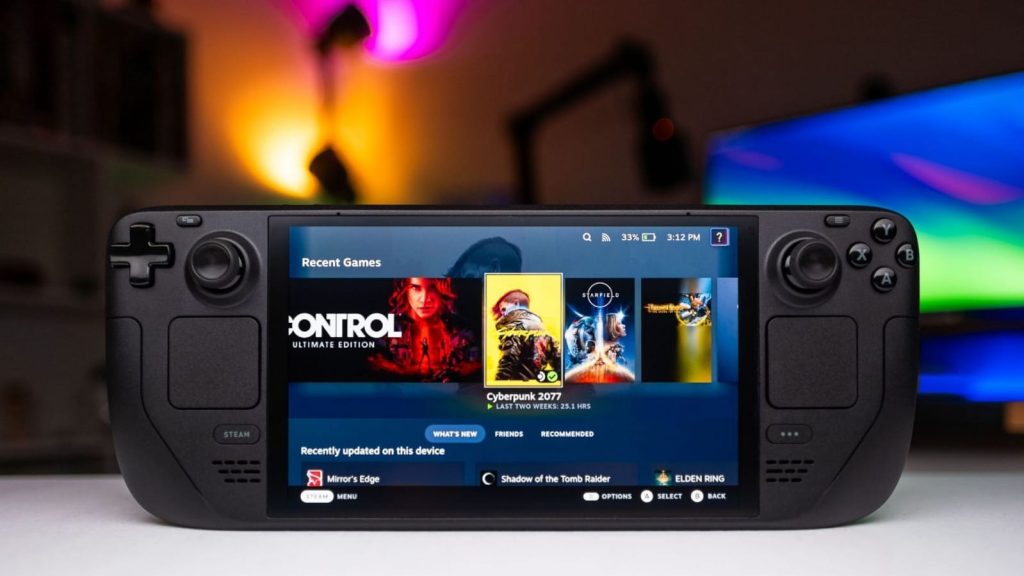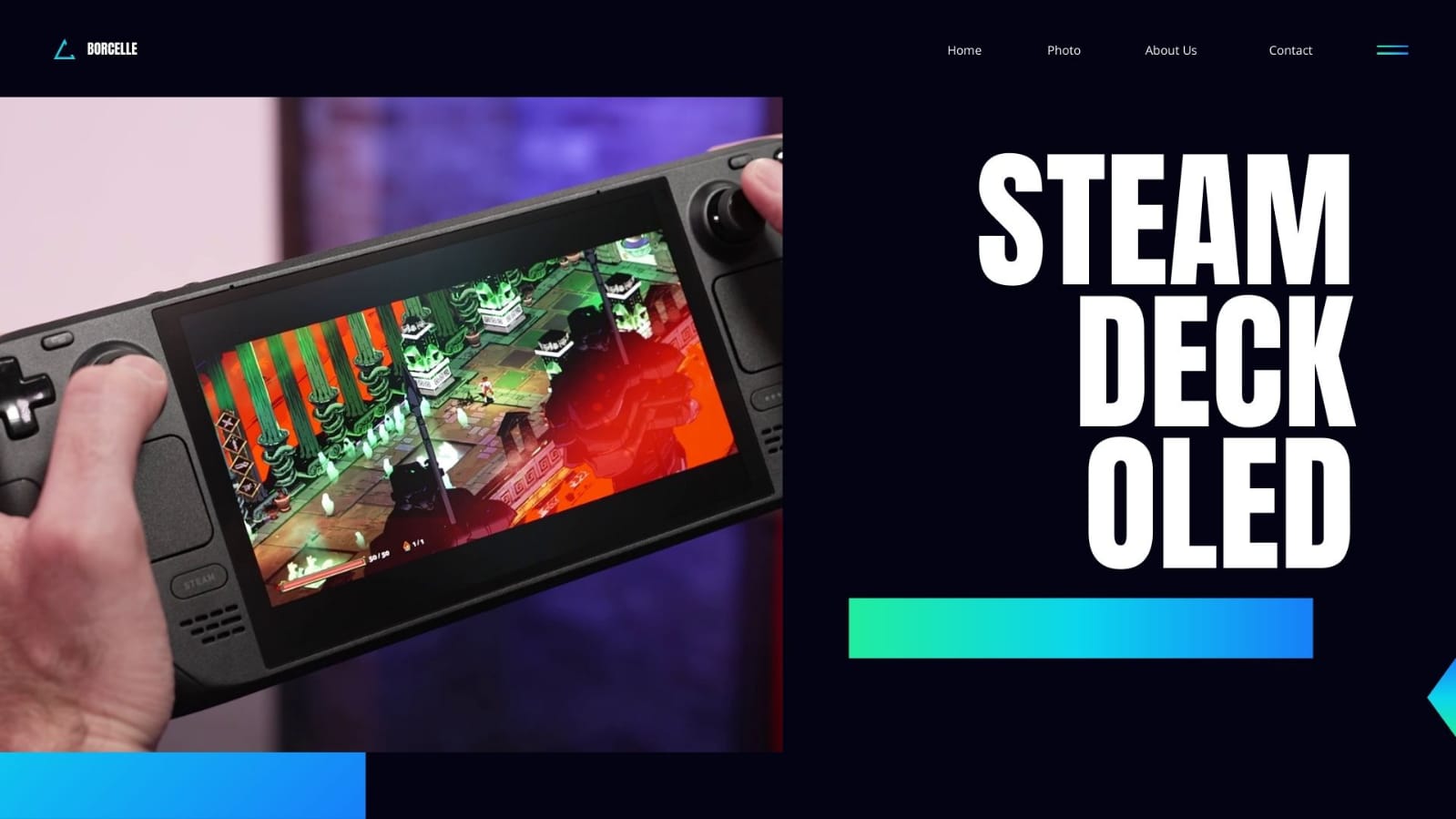I did not think that this would happen anytime soon. We had multiple publications stating that this wouldn’t happen at all. But then it showed up in the studio, and I couldn’t believe my eyes—a fully refreshed Steam deck, and I mean fully refreshed. Every single major component of the system is new. We have a larger OLED display, and we have a new chip—a 6-nanometer chip—that – more energy-efficient. We have slightly tweaked sticks, the touchpad, the speakers are better, the battery is bigger—longer battery life—and we have an improved thermal system. Let’s just get right into it.
Let’s start off with the exterior dimensions, because that’s one of the very few things that hasn’t really changed per se. The biggest difference is the presence of this new orange power button. It just signifies the kind of new version of it. Even the screen cutout is the same as the larger panel, but because of the thinner bezels, the old accessories all work. So the kill switch from Dbrand still fits perfectly, and the same with their screen protectors.
All right, let’s start with the displays. So this is the previous model, like the original Steam Deck with its 7-inch display. So it was a 60 Hz panel, 400 nits, but the biggest issue with it was really the color reproduction. It was just not a particularly colorful or color-accurate display. And I think when it comes to games, a lot of the subtle details and visual nuance of games are just lost when you’re displaying them on a mediocre screen. But with this new panel, it’s a different story. We’ve got a 7.4-inch OLED that runs at 90 Hz, 600 nits of brightness that goes up to a thousand nits for HDR content—it’ll peak up there. It’s more energy-efficient because it’s OLED; it’s got way better contrast. So the benefits of this display are immediately noticeable in pretty much every game. Bright and colorful games look awesome, like you’d expect, but even dark and moody games are significantly better because the blacks are just black instead of like a gray backlit pixel. It’s just so much nicer-looking. And also, HDR content for the games that do support it looks awesome, like the bright elements just blasting out of the screen at a thousand nits. Now this display is also a 90-Hz panel, and on games that make use of it, like this one, Dead Cells, it’s just immediately noticeable. It’s difficult to convey the kind of increase in frame rate on a 60-Hz video like you’re watching, but if you’ve just played any high-refresh game, the difference from 60 to 90 is very significant. Keep in mind, though, that there are other devices out there with significantly faster screens and more powerful processors, but the fact that the Steam Deck went from 60 to 90 is already a huge win in my books.

Now, in terms of the screen size, it’s not massively larger, so it’s a little bit bigger, but I would say that the improvements that you get from the new Steam Deck do not come from the screen size, at least for me. It’s also the same resolution, still 1280 by 800; it’s just that the image quality is so much better. Now one last thing, if you’ll remember, Steam Decks come in three configurations: the base model, the mid-tier, and the top tier. But only the mid-tier and top-tier are going to get this OLED refresh. So the top-tier configurations like this unit here have this anti-glare etched glass finish to them. And the purpose of it is to kind of cut down on some of the reflections. So this unit here does not have that etched glass coating. So if you’re in a really bright environment or a brightly lit room, sometimes those reflections can be a little bit harsh, right? But here, they’re diffused a bit.
The problem is, though, that because it’s an OLED display, I feel like you lose some of the OLED properties, like the popping colors and the really black blacks, because of that matte finish on that etched glass. So as a demonstration, this is like a screen protector. This is going to be a very crude demonstration, but hopefully it gets the point across. If you give it a second for this screen to kind of fuse on, or the protector to fuse on, look at the difference in the color, like look at the black part of the menu there, right? On the left side is that etched glass. It’s almost lost its true black nature because of the OLED, right? But on the right, with that smooth screen protector on it, it’s still quite dark. So I’m just thinking if you’re going to purchase one of these things, unless you really care about brightly lit environments and you want to cut down those reflections badly, I would opt for the regular screen without that anti-glare property.
The new device also has slightly better sticks in the sense that the rubber top has a bit of a lip to it, so it’s just a nice sort of grip. It’s also a different ball joint color. It’s black instead of gray, but the shoulder buttons also had a bit of an upgrade. So on the old one, I found that if you held them down for too long, they would sort of get stuck a little bit, and you’d have to kind of push them back out. But on this new one, they’ve got a bit more tactile feedback, and they don’t stick as easily. So that’s a nice upgrade. The touchpad is also slightly better. It’s a little bit more responsive, and it’s got a nice sort of clicky feel to it. And the speakers—they’re not like night and day better, but they are a bit louder and clearer. So they’re definitely an improvement. And then, of course, we have the improved battery life. So on the original Steam Deck, you were looking at about five to six hours of playtime, depending on what you were playing and how bright you had the screen.
But with this new one, you can expect to get around eight hours of playtime, which is a pretty significant jump. And then, finally, we have the improved thermal system. So the original Steam Deck was pretty good at keeping everything cool, but this new one is even better. It’s got a slightly larger heat sink, and the fan is a bit more efficient. So it’s able to keep everything running smoothly, even during longer gaming sessions. All in all, I have to say that I’m pretty impressed with this new Steam Deck. It’s not a complete overhaul, but it’s definitely a significant upgrade in pretty much every area. The new OLED display is a real game-changer, and the improved battery life and thermal system are nice bonuses. If you’re in the market for a portable gaming device, I would definitely recommend checking out the new Steam Deck.



